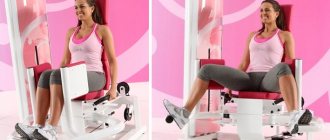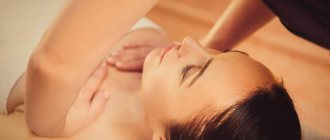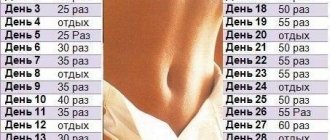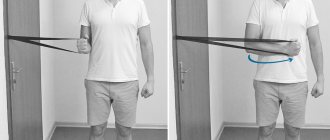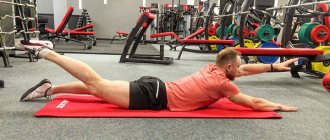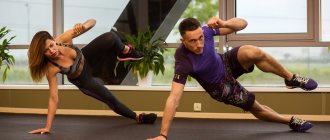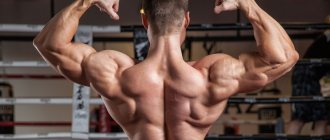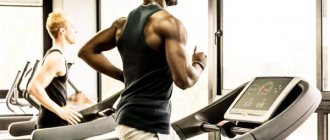Increasing the volume of the chest is the task of a whole set of exercises for training in the gym. They should not be neglected: in addition to favorable external changes, increased breast volume improves the quality of breathing and blood supply to tissues and internal organs. For men leading an active lifestyle, such exercises can visually enlarge the upper torso and improve its definition. For women, pumped up muscles of the pectoral girdle lift the breasts, thereby providing visual attractiveness. The set of exercises is highly effective and allows you to thoroughly “modify” the muscle structure. Special training, adherence to a number of simple accompanying rules and confident pursuit of the goal are the key to success, which will make itself felt very soon.
Breathable pullover
From the outside, the breathing pullover is similar to a regular “basic pullover”, because... when performing it, the arms with weight are also moved behind the head. But there are important distinctive nuances in performing a breathing pullover.
Firstly, the breathing pullover is performed with minimal additional load. You can use dumbbells, preferably up to 5-7 kg. If you don’t have dumbbells, you can use a bottle or a bottle with water or sand.
Secondly, the movement of the arms with weight behind the head is performed with a minimal bend in the elbows. This is very important, and this is how a breathing pullover differs from a power pullover.
In gyms, pullover is usually performed while lying on a bench.
Pullover over the bench
At home, a breathing pullover can be performed on a bed, on the floor, on the back of a chair or sofa (provided that they are of sufficient thickness and softness), on a chair or fitball. You can also perform the breathing pullover while standing. Each option has its pros and cons.
The main thing is to concentrate on the lower back, preventing any movement of the lower body and keeping your arms as straight as possible at the elbows.
Chest opening complex
Yoga Journal, No. 15, September/October 2007, https://www.yoga-journal.ru/
A set of asanas developed by Konstantin Kovalev will help open the chest and feel the joy of free breathing.
In yoga classes, we are encouraged to listen to our body and only then make adjustments to the asanas. But what to do if the body stubbornly remains silent? What if the words “turn your thigh inward” or “press the outer edge of your foot to the floor” are meaningless to us?
If you feel that some parts of your body are not responding to brain signals, do not despair. After all, having realized this, you have already crossed the next milestone in practice and are ready for serious changes. The only thing that is required of you is to focus on the “silent” zone and work with it carefully.
First, do not hesitate to tell your teacher about your difficulties. An experienced teacher will always point out to you an area of the body that is too tight, weak or overstressed. Find out which asanas and with what emphasis you should perform in order to feel and “awaken” the problem area.
Having received answers to your questions, include the poses you need in your home practice. The changes won’t take long: very soon you will feel improvements not only in the “naughty” area, but throughout your whole body.
The thoracic spine is one of those areas of the body that is most difficult to “get to.” Correct chest position promotes calm, deep breathing and instills confidence and strength. If you have not learned to open this area and lift it up, doing breathing exercises loses all meaning. Unfortunately, when performing asanas, many of us do not feel this part of the body and, as a result, do not understand what to do with it, even when we hear clear instructions. Indeed, opening and expanding it is not so easy, especially if the poses are performed without auxiliary materials. The following set of asanas will help you “hear” the problem area and teach you how to correct its position. During practice, do not pay too much attention to the entire pose, but focus on the area you are working on.
Bharadvajasana IVariation. Pose Dedicated to Sage Bharadwaja I Sit on the floor in Dandasana (Staff Pose). Bend your knees and place your feet to the left of your pelvis, with your left foot resting on your right. Knees point forward. As you inhale, extend your arms up. As you exhale, turn your body to the right, place your left palm behind your right thigh, and your right palm on the floor behind your sacrum. Feel how difficult it is in this position to lengthen the spine and open the chest. To align the right and left sides of your pelvis and create a solid base for the pose, sit on a support. Turn your body to the right and place your left palm behind your right thigh and your right palm behind you on the brick. Make sure that your pelvis does not “fall” to the right. When twisting, do not look at the floor - looking straight ahead helps lift the chest. Hold the pose for a few breaths, and then perform it in the other direction. |
TadasanaMountain Pose with Hands in Gomukhasana (Cow Pose) Stand in the center of the mat, feet together. Extend your arms along your body. Lengthen and widen your feet, pressing them firmly to the floor - this will make the pose stable. Draw your knees in and push your hips back slightly. As you inhale, raise your arms up. As you exhale, lower your right arm down, bend it at the elbow, place it behind your back and move it up until your palm is between your shoulder blades. Bend your left hand and grab the fingers of your right hand. In this pose, the chest tends to move forward. To make it rush upward, move your right shoulder back. Stay in the pose for several breathing cycles. Perform the asana in the other direction. |
Bharadvajasana IWhen performing this variation of the pose, place your right arm behind your back and, bending it at the elbow, grab the shoulder of your left arm slightly above the elbow. Place your left palm behind your right knee. Stay in the pose for a few breaths and then repeat the twist on the other side. |
Utthita ParsvakonasanaExtended Side Angle Pose Stand in Tadasana. Jump your legs 120 cm wide. Stretch your arms to the sides. Turn your left foot slightly inward and turn your right foot outward from the base of the thigh. As you exhale, bend your right leg at the knee, lean to the right and lower your right hand to the floor in front of your foot. Extend your left arm along your body, turn it from the inside out and move it above your head. In this position, it is very difficult to lower your shoulders and turn your chest towards the ceiling. Support under your right palm will help you perform these actions. Lower it onto a brick and compare the sensations in your chest. Stay in the pose for several breathing cycles. Then perform the asana in the other direction. |
VasisthasanaPose Dedicated to Sage Vasistha Enter Adho Mukha Svanasana (Downward Facing Dog). Move your right palm to the left so that it is in the center of the longitudinal axis of the mat. Turn your right foot with its outer edge toward the mat and place it in line with your right palm. Press the inside of your left leg against the inside of your right. Turn your entire body to the right. Balancing on your right leg and right arm, point the outer edge of your left foot away from the floor. Press your right palm firmly onto the floor and extend your fingers. Point the right side of your chest forward and pull your left shoulder back. Hold the pose for a few breaths and then repeat on the other side. |
Ardha ChandrasanaCrescent Moon Pose Stand in Tadasana. Jump your legs 110–120 cm wide. Stretch your arms to the sides. Turn your left foot slightly inward and turn your right foot outward from the base of the thigh. As you exhale, bend to the right and grab your right shin with your right hand. Bend your right knee, place the fingertips of your right hand on the floor in front of your right foot, move your left foot closer to your right, and inhale and lift your left leg until it is parallel to the floor. Feel your chest “falling”. To rotate it upward, place your right hand on the brick. As you retract your right shoulder blade, push the right side of your chest forward while moving your right shoulder back. Extend your left arm up. Look straight ahead. Stay in the pose for several breaths. Perform the asana in the other direction. |
Adho Mukha SvanasanaDownward Facing Dog Sit on your heels and spread your knees hip-width apart. As you exhale, bend over and lower your head to the floor. Extend your arms forward, palms shoulder-width apart. Raise your pelvis and straighten your legs as you inhale. Widen and lengthen your feet, pushing them off the floor. To stretch your lower back, press the front of your thighs toward the back of your thighs and lift your kneecaps up. Don't push your head toward the floor. To draw in the ribs of the upper back and lengthen the thoracic spine, point the base of the sternum toward the pelvis. Hold the pose for several breaths. |
Bharadvajasana IISit in Dandasana. Bend your left leg and bring it into Virasana (Hero Pose) position. Place the front of your right foot on your left thigh as close to your pelvis as possible. If your knees hurt in this position, perform Bharadvajasana I. Turn your body to the right and place your left palm behind your right knee. Move your right shoulder back and grab your right big toe with your right hand. To lengthen your right hip and lift your ribcage, place a brick under your right knee. Move your right elbow away from your back and lift the area under your left collarbone up. Hold the pose for several breaths. Repeat the asana on the other side. |
Peary Raider thrust
This exercise was invented by Piri Rader. The exercise is not strength training and does not require equipment.
Initial position. Stand near a vertical post, pillar, door frame, maybe at the corner of the wall, at a distance of outstretched arms, but slightly bent at the elbows. You must grasp the counter at a height above your head.
Relax your abdominal muscles and take a deep breath, filling your chest completely. Tighten the front muscles of your neck and tilt your head back slightly. Pull your arms towards you so that the lower part of your chest rises. At the same time, you should feel stretching and tension in the sternum.
Do 10-15 repetitions-cycles in each approach, with the duration of one breathing cycle being 5-6 seconds.
Experiment, everything is very individual, distance, leg placement, grip height.
When you begin to “ feel ” the movement and muscles, try exhaling and inhaling at the top point while simultaneously pulling your chest upward more strongly.
Age characteristics and useful exercises
Many young people are interested in the question of how old the chest frame grows. Typically, growth in boys begins at the age of 12 and stops by the age of 18; the most intense activation is noticed at the age of 14-16 years.
Chest enlargement is easy if the young person is not yet 20 years old, and preferably 18, since this time is most favorable for the growth and development of the skeleton.
In subsequent years, bone growth slows down and breast expansion will become problematic. Of course, if you continue to do certain exercises, the effect will also be present, but less pronounced. Muscle can always be built up, since hypertrophy of muscle fibers is achieved in 2 years. Muscles can build and deflate over the course of life, but the width of the chest will remain for life.
Many young men are interested in the question of what chest volume is normal. Typically, normal indicators vary in the following sizes, depending on the constitution of the young man:
- 14 years – 75-83 cm,
- 15 years – 77-84 cm,
- 16 years – 80-89.9 cm,
- 17 years old – 82.9-92.2 cm
If a young man has changes to a greater or lesser extent, then these indicators should be brought to the attention of a doctor.
Physical exercises known to the people will help develop the chest. However, there are not so many of them; the most common and effective include:
Breathing squats. When performing this exercise, you must be moderate in choosing additional weight. Heavy weight can injure muscle fibers; the additional load should be comfortable when performing the exercise. The technique itself is no different from classic squats, however, they are accompanied by such a feature as breathing exercises.During the first squat, you need to take a deep breath, and when straightening, exhale slowly and deeply. After 5 squats, you should take an additional number of inhalations and exhalations. In order to achieve better results, it is recommended to do 15 squats per approach. The most popular breathing patterns are the following approaches:
- 1-6 repetitions: one inhalation and exhalation,
- 13-20 repetitions: three inhalations and exhalations.
6-13 repetitions: two inhalations and exhalations,
It is impossible to knock down or produce rapid breathing, because breathing is considered the most important part of the training process. After you have completed the recommended approaches with squats, you should proceed to the next exercise as soon as possible - the pullover. Rest between the pullover and the squat is prohibited.
- duration of the first cycle – 4-5 weeks,
second cycle – 5-6 weeks,
Advice: Usually the result becomes noticeable after 2 or 3 cycles, but you don’t need to stop at the achieved result, you should move forward. Pullover is the most effective exercise for boys under 25 years old.
To perform it, you need to lie on a bench, and the weight should be pulled out from behind your head, leaving your arms straight. To begin with, you should take dumbbells no more than 5 kilograms or an empty bar. Over the course of a month, the load gradually increases to 10 kilograms. A further increase in load can only be done if the young man can bench press about 115 kilograms.
Additional exercises to expand and enlarge the chest
As progress is made by performing the exercises described above, you can add new exercises to the program and increase the load.
To strengthen the pectoral muscles, it is necessary to combine pressing exercises with stretching movements.
At the same time, include in your workout one great exercise for 5 parts of the body, which perfectly stretches the pectoral muscles.
Physiology of the pectoral muscles
All the muscles of the torso are attached to the rib cage, which consists of ribs and costal cartilages that provide connection to the sternum. Cartilage also adds elasticity to the frame, which can be seen when doing heavy cheat presses when the bar accidentally falls onto the chest and bounces off it.
The structure of the costal cartilages lengthens over time, resulting in gradual adaptation to load. They increase the overall length of the arch of the ribs and expand the chest. But it is worth remembering that cartilage hardens after 25 years, so after this age, stretching it becomes extremely difficult, and in some cases, this method of breast expansion becomes impossible.
The intercostal muscles are located in layers between the ribs all the way to the surface. During breathing, strong muscle contraction occurs, and in case of sufficient development, the size of the breast increases significantly. That is why, after 25 years, it remains possible to expand the skeleton through careful training of the muscles located between the ribs.
The serrated anterior muscles are located on both sides of the chest. They press the shoulder blades against the chest wall and pull forward.
Normal sternum shape and deviations
The chest is a shield that covers the internal organs. These include the heart and lungs, as well as large trunks of blood vessels. All these elements of the body must be closed and protected.
The normal shape of the chest is an irregular cone. It should have four sides.
Breast shapes are divided into several subtypes. They depend on the constitution of the person. The types of chest are divided into:
- Normosthenic – conical chest. The diameter of the anteroposterior sides should be less than the lateral one. This distinguishes the normosthenic form of the chest from other types. The spaces between the ribs are almost invisible. The shoulders are at an angle of 90 degrees relative to the neck. The muscles of the peri-shoulder zone are developed. All indicators of such a chest are normal,
Hypersthenic. Feature: cylindrical shape. The lateral and anteroposterior dimensions are almost equal. The size indicators in this case will be larger than the norm. A hypersthenic chest involves straight and broad shoulders, horizontally positioned ribs, with narrow gaps. The cylindrical chest is quite wide, the muscles are also quite developed.- Asthenic. An asthenic has a flat, narrow and slightly elongated sternum. The anteroposterior and lateral dimensions will be smaller than in any of the described types. The collarbones and the pits above and below them stand out well. The asthenic chest is characterized by very large intercostal spaces. The shoulders are usually drooped and the muscular system is weak.
Reasons for changes and their types
During the deformation of the chest, its shape changes, which has a negative impact on the functioning of internal organs - the heart, lungs.
In medicine, a distinction is made between congenital and acquired deformities.
Acquired deformity is a curvature of the shape of the chest due to some diseases, for example, diseases of the respiratory organs, rickets, bone tuberculosis. Burns in the chest area and various injuries can deform the sternum.
Acquired deformities are divided into the following types:
- Emphysematous - occur as a result of inflammatory processes in the lungs and respiratory tract, emphysema. In this case, the front part of the chest increases in size.
- Paralytic - a prerequisite for such a change is diseases of the lungs and pleura. The paralytic chest is characterized by reduced parameters.
- Scaphoid – boat-shaped indentations appear in the upper and middle parts of the chest. The scaphoid chest appears due to inflammatory processes in the spinal cord.
- Kyphoscoliotic - observed in cases of changes in the structure of the spine (asymmetry of the chest is formed, or a crooked spine appears).
The main reasons for such changes:
atrophied bone tissue,- changes in bones due to age,
- rupture of intervertebral discs,
- spinal fractures,
- neoplasms (tumors),
- damage, damage
- osteoporosis,
- deformation of the structure of the spine and vertebrae.
Congenital pathologies
Congenital chest deformity is the most common and dangerous phenomenon. Among the changes in this case, several types of deformations are distinguished:
- Funnel-shaped. Atypical costal cartilage or diaphragm can have a deforming effect. This type is characterized by the central part of the chest pressed towards the spine. This creates a funnel. This pathology reaches its greatest development by the child’s third birthday. If in the early stages it can be treated with gymnastics, then in the later stages only surgical intervention is used.
More than 20 types of operations are used in the world to correct this type of deformity. - Keel-shaped, or chicken-shaped. In this situation, the costal cartilage grows. This causes the sternum to move forward.
The shape of this deformation of the chest in a child resembles a keel. If this disrupts the functioning of internal organs (heart and lungs), then at the age of 5 years surgical treatment – thoracoplasty – is allowed. In the initial stages, chest deformity involves exercise, swimming, and the use of physical therapy. May occur as a result of rickets.
The following factors influence the development of the chest:
- Genetic predisposition - if one of your relatives has had such deformities, then there is a risk of passing them on as an “inheritance” to children, grandchildren and great-grandchildren,
- Developmental defects - if there are many developmental abnormalities, a child may develop a similar pathology.


